
Can We Find Happiness Together Again?
An interview with Samuel Leuenberger, curator of Parcours
Samuel Leuenberger is an independent curator and the founding director and curator of SALTS, a not-for-profit exhibition space in Birsfelden, near Basel. In 2014 he was the associate curator of 14 Rooms, a project between Fondation Beyeler, Theater Basel and Art Basel, and in 2017 – an associate curator of Salon Suisse, the collateral public programme of the Swiss Pavilion at the 56th Venice Biennale. For six years now Basel-born-and-based Samuel Leuenberger has been curator of Art Basel’s Parcours sector. He has has said that “wherever there is a spot in which you can imagine art, Parcours can happen”.
Parcours is Art Basel’s public art programme that was first introduced in 2010. It offers site-specific sculptures, interventions and performances by established artists and emerging talents in the city spaces of Basel for everyone to enjoy.
“Through the lens of enduring an ongoing global trauma, we are finding ways to survive together, work together, and befriend each other anew. The task of mounting an international exhibition seems of second-degree importance, but nevertheless, in these not-quite-post-pandemic times, the impulse to share creatively, to fight to express our freedom through art – through conversations and encounters – is paramount. Everyone is called to give a hand in creating a common space of care, congeniality, and empathy. For the 2021 edition, ‘Can We Find Happiness Together Again?’, Parcours is mobilizing friends from all around the world – gallerists, artists, and colleagues in Basel – to co-host this communal platform through 20 site-specific artist commissions,” says the statement of this year’s Parcours. I spoke to Leuenberger in Basel during Art Basel week, September 20–26, 2021.
Hamish Fulton: Walking In Every Direction, performance, 2021, presented by Galerie Tschudi / Art Basel press photo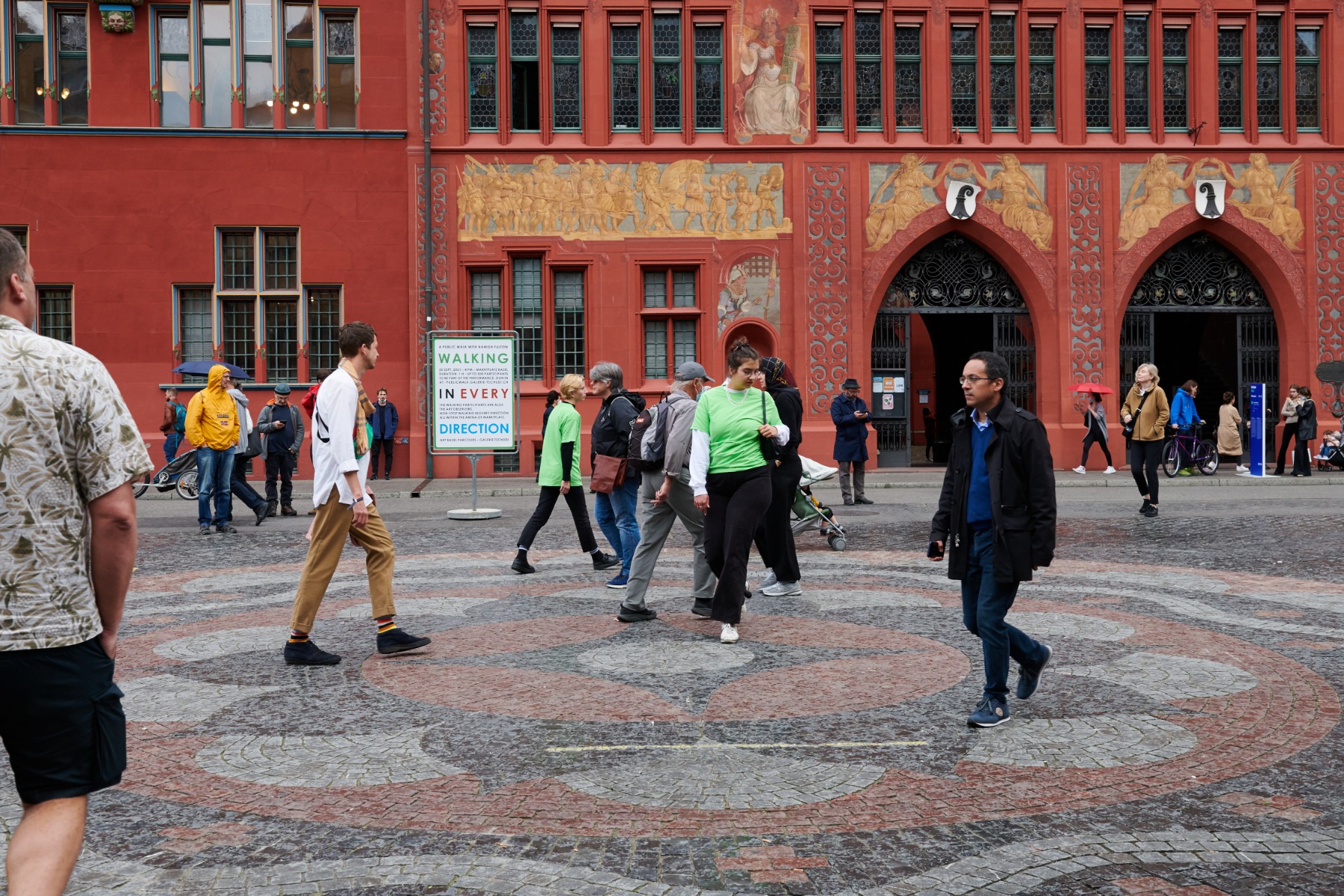
Hamish Fulton: Walking In Every Direction, performance, 2021, presented by Galerie Tschudi / Art Basel press photo
What is special about this year’s Parcours?
For an obvious reason it’s a very pandemic-friendly display of art. It’s for free and it’s for a larger public. It’s really at the cross-section of art experts and the general public. People walk by, they walk in and they discover something. It’s the only show of Art Basel that is free of charge. You don’t need a ticket.
Has it always been like this?
It has always been like this. I always joked about it that it’s the opposite to what is happening at the art fair: it has a lot more space, it’s only 20 projects (not ten thousand works of art – who knows how many artworks there are in the art fair?!), and there is a much bigger visibility for these works. There are 10 000 people who visit Parcours. If you’re an artist with work somewhere in a booth in the art fair, you’re one in a million.
There are more people who are taking their time to walk through Parcours this year. It’s between the outside and inside; it’s nice. Even if the room is full, it’s never very full. You never go into a room where there are more than 30 people. Through rearranging Parcours, we also rearranged the route because many of the places we normally work with were occupied. We have 15 locations that are brand new out of 20 in the city centre. It’s very exciting even for people who visit every year.
Claudia Comte: The Interview Painting Ensemble (mise-en-scène in 12 Acts), 2021, presented by König Galerie, Gladstone Gallery / Art Basel press photo
I was very curious to see Claudia Comte in Stadtcasino.
The Stadtcasino that nobody has seen. It was renovated two years ago and it opened in August 2020. The first performance took place there in October and only 50 people were allowed to go listen to a classical music concert. It has 1400 seats and only 50 people could be seated in order to allow enough distance between them. Hardly anyone in Basel has seen this building that’s been newly renovated by Herzog de Meuron. Many of the spaces – like the Theater Basel, which is also old – have been freshly renovated. All of these are really exciting locations. So it’s great fun to visit them.
Claudia Comte: The Interview Painting Ensemble (mise-en-scène in 12 Acts), 2021, presented by König Galerie, Gladstone Gallery / Art Basel press photo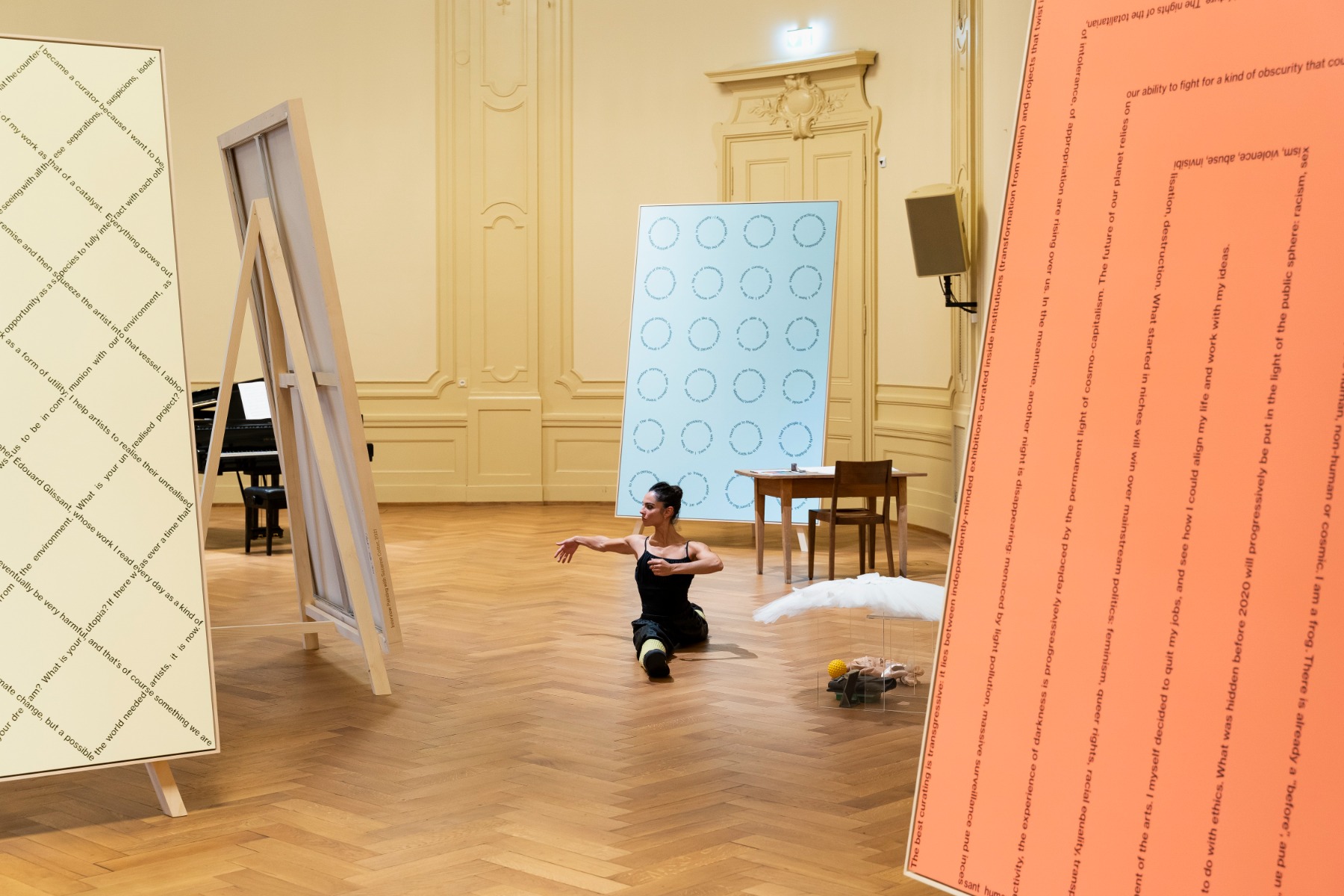
Is there something mentally that has changed in people, making them more interested in art in public spaces?
I don’t think anything has changed in art in the public space. People want to see art in real environments. There is an interest to connect to an environment and to some kind of a narrative. This is exciting for people. For someone who is not necessarily an art professional, it’s much harder to look at art in an Unlimited section or an art fair booth. Because it’s more abstract and it’s more busy – it’s more confusing. In Parcours, every project is almost a mini solo show. You go to one project, you see one artist, you see an environment, you connect to the architecture. There is a quality about it that is very anti-speed.
People want to see art in real environments. There is an interest to connect to an environment and to some kind of a narrative.
In the text, you mention that you brought in your friends. How did the selection process work this year? Is collaboration more difficult or, on the contrary, easier because of Covid?
It was more difficult, for sure. The lack of travel and the lack of possibility in starting new conversations limited the scope of activity.
Augustas Serapinas: Mudmen, installation, 2020, presented by Emalin / Art Basel press photo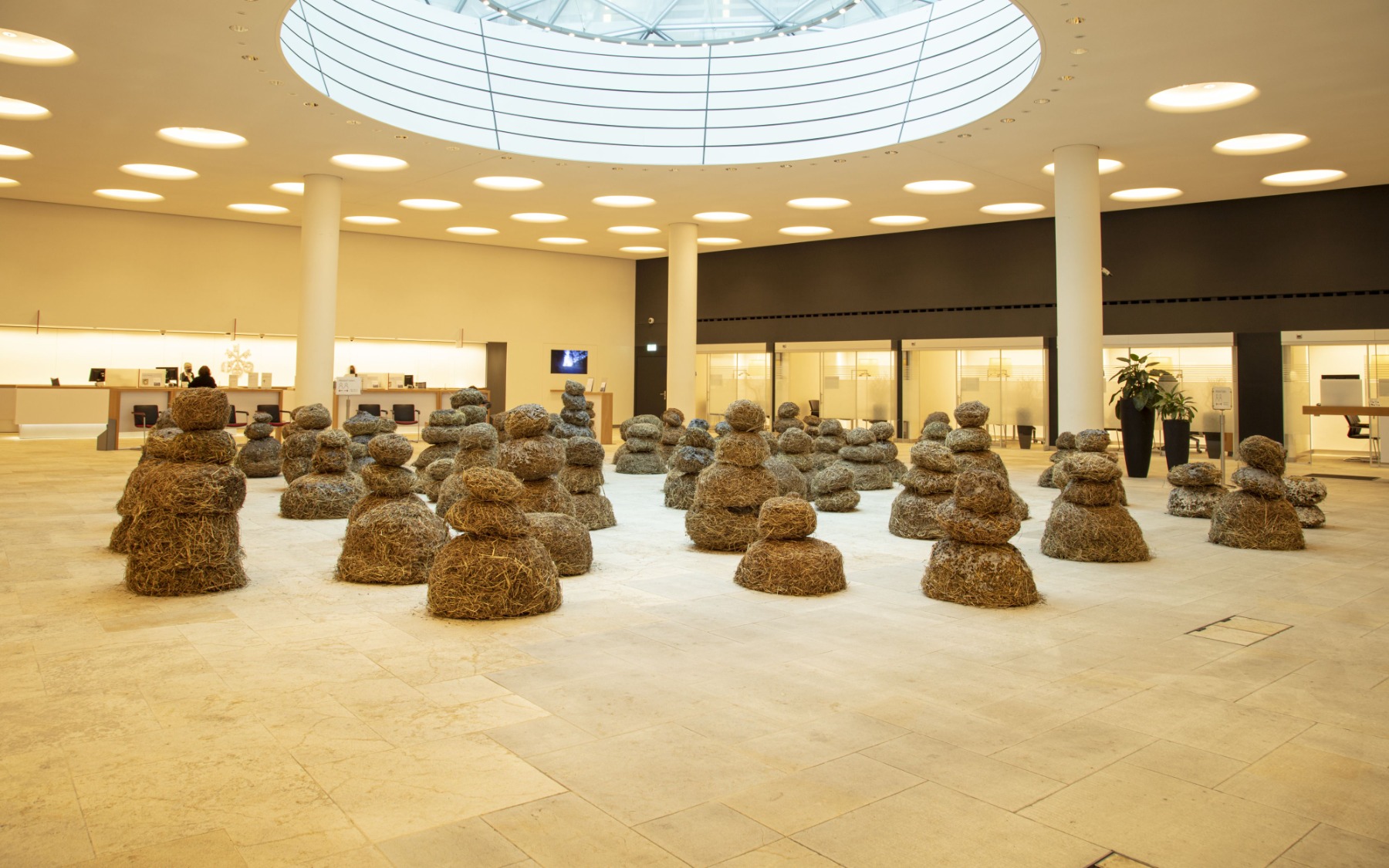
In your search for artists, did you contact the artists first or the galleries?
I have a lot of good old friends in this year’s Parcours. Because of the difficult time we’re in, I contacted people I already had confidence in – I had their trust and friendship. There are a few artists that are new to me, but in general it was not an experimentation with new artists. That made things easier. And not just easier – we didn’t know if the fair would even take place, or if we would have to change locations… It was a really difficult process. But since I was working with people I had worked with in the past – for instance, Augustas Serapinas – it came out really good. We know how we work together. We trusted each other. In the end, it was a more relaxed Parcours. It’s a bit younger compared to other years.
The same goes for galleries. I first work with an artist, and then I go to the gallery. But also vice versa. I worked with many galleries that I had worked with in the past. That allowed us to skip many problems, a lot of naive problems like getting to know each other – things that are normally fun.
Usually I have a wishlist. I always like to mix very young artists with more established artists. For example, I have Mike Nelson in this year’s Parcours. I have wanted to work with him since I started. I had been in conversations with galleries for years but it was never possible. Now it was finally possible. Sometimes conversations take many years. It’s a project that requires a lot of patience.
Augustas Serapinas: Mudmen, installation, 2020, presented by Emalin / Art Basel press photo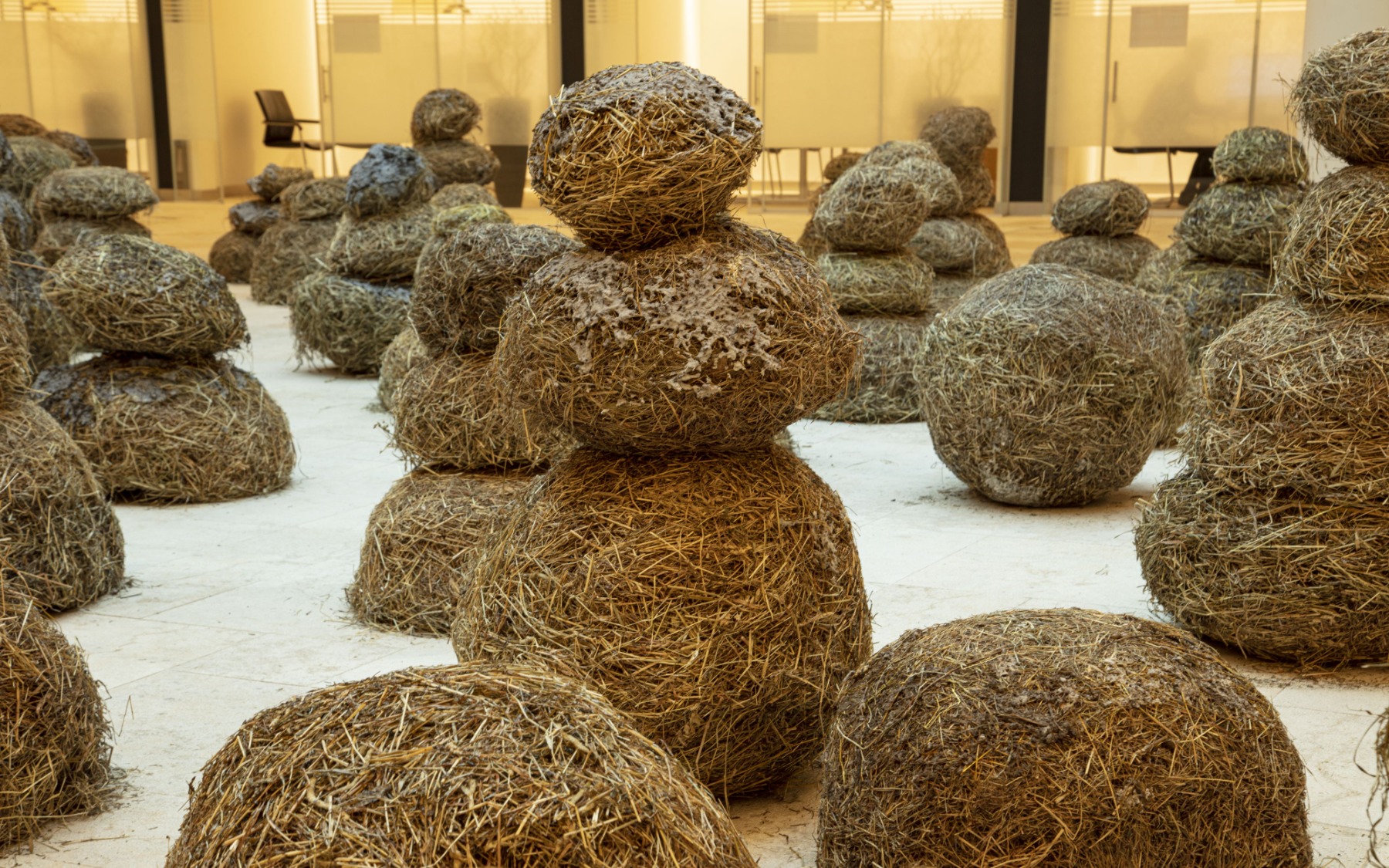
Despite the complicated times, you have managed to get Parcours into places that are normally inaccessible, like all these stacks of hay by Augustas Serapinas in the UBS lobby. It’s amazing!
It was a string of positive coincidences. UBS is one of the lead partners of Art Basel. In the past they usually hosted the BMW Art Prize, so the space was never an option. But because of the pandemic, this had shifted and the room became available. A lot of opportune things happened this year that most likely wouldn’t have happened in a normal year. For example, this year we have a show in a bed shop called Passion for Beds. It’s a luxury bed store. It’s a location I had been talking to for three years, but we never got to work with them until this year. The artist Yuli Yamagata really liked the space, and she did a wonderful installation there this year.
A lot of opportune things happened this year that most likely wouldn’t have happened in a normal year.
How do you choose locations that are on your wishlist?
We have a map of the area. We know who is willing to work with us every year. But I always try to find new locations. It’s constant research and making things possible. It’s a chess game. You have to be flexible enough to react when there’s an opportunity.
Jason Dodge: Untitled installation in Kunstmuseum Basel, 2021, presented by Galleria Franco Noero / Art Basel press photo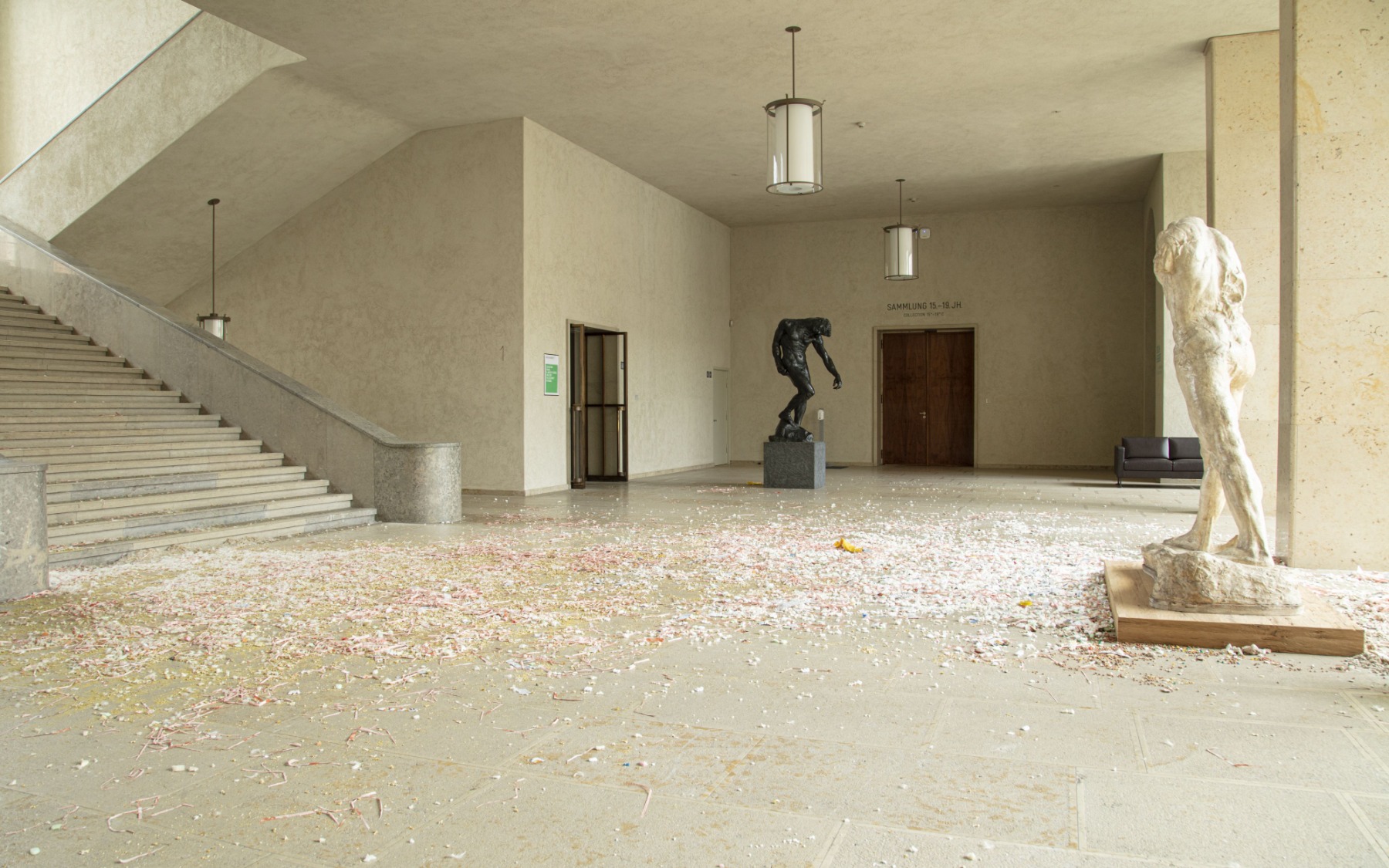
You’ve been the head of Parcours for five years. How do you feel?
It’s usually a shorter mandate. My two previous colleagues worked for three years each. One was based in New York and the other was from Paris. I have been in this position longer because I am on site. The previous curators came here only two times a year to do site visits. Whenever I have an artist here, I walk through the area with them; I can spend time with them. It makes a big difference. The quality is different.
Jason Dodge: Untitled installation in Kunstmuseum Basel, 2021, presented by Galleria Franco Noero / Art Basel press photo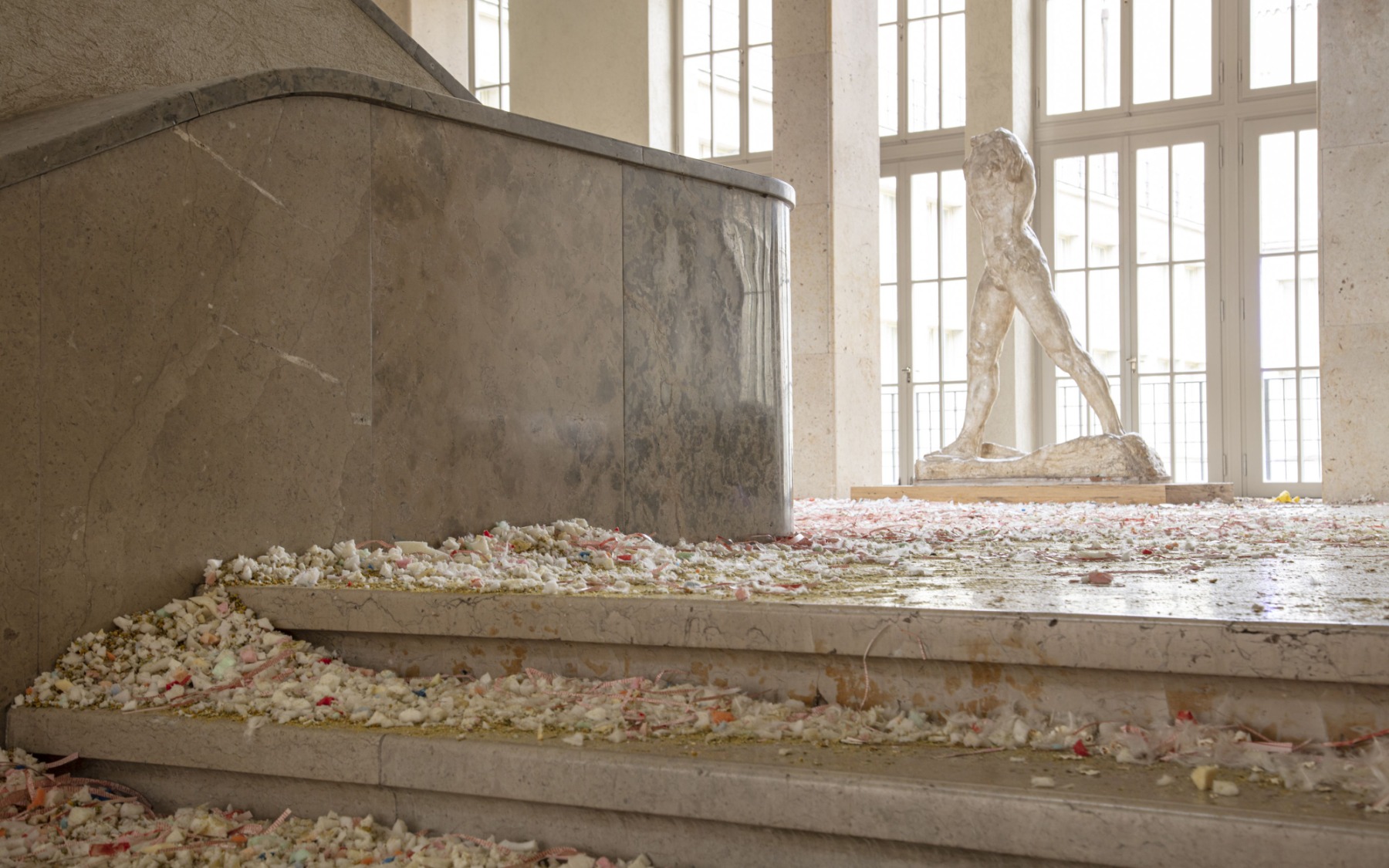
What is your relationships to Art Basel like? Do they just entrust you with money and allow you to do anything?
No. The Unlimited, Parcours and Film sections are the three sectors which are financed by the galleries. The only limitation I have is that I have to work with a gallery that is here at the art fair. Art Basel pays for the rental of the locations, the infrastructure, and the manpower (guides), but the actual projects – building them up and taking them down – is covered by the galleries. Luckily, I don’t need to work with that sort of budget. Art Basel takes care of the budget as well as provides a producer who has been organising all eleven Parcours editions. It’s a small team. We’re only three main people. One does all the legal stuff and paperwork (contracts, rents), and the producer does all the feasibility checks, etc. But again, it’s a fun process. And it’s a long process. Because first I have to meet the artist, then find a location, the artist has to make a project proposal, and then the location has to be approved. Only when it’s approved does the producer calculate all the costs. Then the gallery approves all the costs. There are many steps where one can say “No!”, or it gets too expensive, or we realise the door is too small and the work doesn’t fit through it. Sometimes it’s a small, silly thing that can make the project stop half-way through the process.
Bunny Rogers: Neopets Techo Statue, 2021, presented by Société / Art Basel press photo
Nevertheless, you’re saying that galleries have become more appreciative of this format of presenting artwork.
Yes, especially younger galleries realise this. It’s more interesting to see when the larger galleries realise this because, of course, everyone comes here to sell, to make money. Parcours is not really a sales platform. Things are for sale, but it’s not really a sales platform. Of course for the larger galleries, who need a big turnover, it doesn’t necessarily make sense to do a project in Parcours. Why is that? As they say: We don’t earn money there, it’s not a museum show… Still, slowly but surely, more and more galleries are realising that it is not a competition and that the costs of projects are often minuscule compared to Unlimited or the main fair. You can do a great project in Parcours that is not big: you can do a project in a store that is an intervention. It’s the right thing at the right moment. You can create magic without a $200,000 installation. This is what people are realising now. And that is OK.
The great thing about doing Parcours for the fifth year is that it gets easier every year: it’s more natural, people understand it more. It’s cool.
Bunny Rogers: Neopets Techo Statue, 2021, presented by Société / Art Basel press photo
How does Parcours work in relation to the Basel community?
The Basel community has always loved it.
How do you know that?
When it starts, everybody goes out to see it: the general public and the Art Basel people. They enjoy looking at it. It’s a great way to see great art. There are other cities where art in public spaces is harder to establish because people are not used to it. Basel has always been a very big philanthropic, cultural city. The general public is very well sensitized to welcoming this sort of stuff. We never have a hard time. It’s very rare that we need to convince someone that something is interesting or that it’s good. The doors are always open. It’s nice.
Basel has always been a very big philanthropic, cultural city. [..] We never have a hard time. It’s very rare that we need to convince someone that something is interesting or that it’s good. The doors are always open.
How involved is the city of Basel itself?
It isn’t financially, but we get the permits from the city, and the culture department of Basel is on our side. It’s also interesting for them to cross-pollinate many audiences. I myself have visited some museums in Basel just because of Parcours. For example, Hanne Lippard placed her project in the Pharmacy Museum in Basel. It’s a museum I had never been to until one and half years ago, when I first went to visit it. It’s an amazing museum! But it’s a tiny little niche museum. It’s weird and quirky. It’s amazing!
Everybody gains from these projects. In a normal year we have 10–12 thousand visitors. All museums are happy because they can click 10 000 more visitors for their statistics. The commercial places are happy because the luxury bed store has the same customers as the art fair: it’s usually rich people who are art collectors, and who is it that can spend $75 000 for a bed? (Laughs)
It’s very rare that this project works against individual interests
Pakui Hardware: Breed, 2021, presented by carlier | gebauer / Art Basel press photo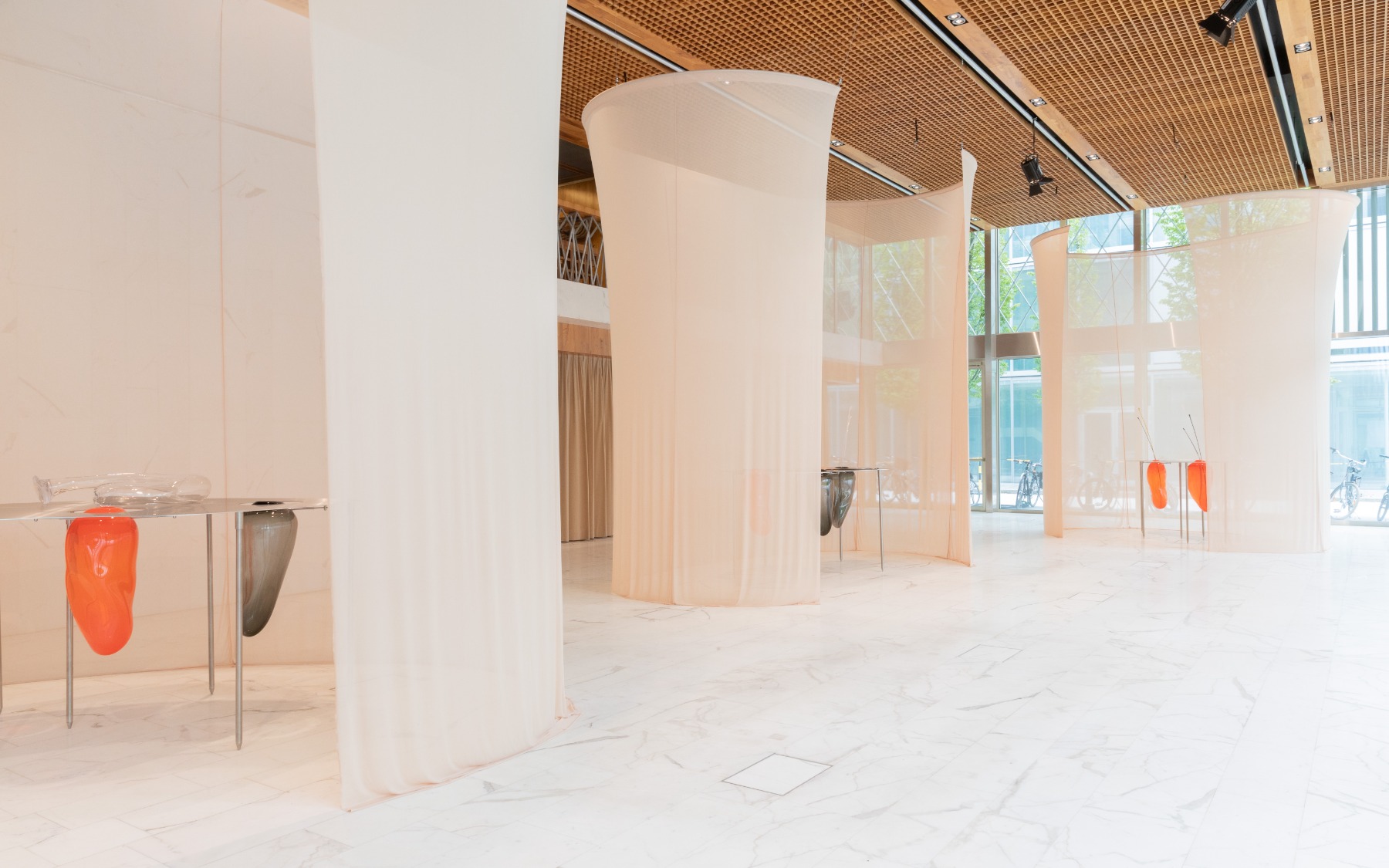
You managed to get artwork by the Lithuanian duo Pakui Hardware onto the Novartis campus. That’s like exhibiting in the Pentagon.
Yes, it’s a closed campus. It’s the first time Parcours is taking place there. 8000 people work there. They have everything there: pharmacies, restaurants, shopping markets, plus a good art collection. To do an art project there is great because it’s a neighbourhood in Basel that 99% of people haven’t yet seen.
It started several years ago, when I mentioned on the radio that I would like to see Parcours in the airport or at Novartis. I mentioned it as a wish. Somebody at Novartis heard this and they responded. Sometimes you have to say exactly what you want, and then maybe things will come together and happen. Perhaps this year will be the beginning of art projects being regularly exhibited at Novartis.
Pakui Hardware: Breed, 2021, presented by carlier | gebauer / Art Basel press photo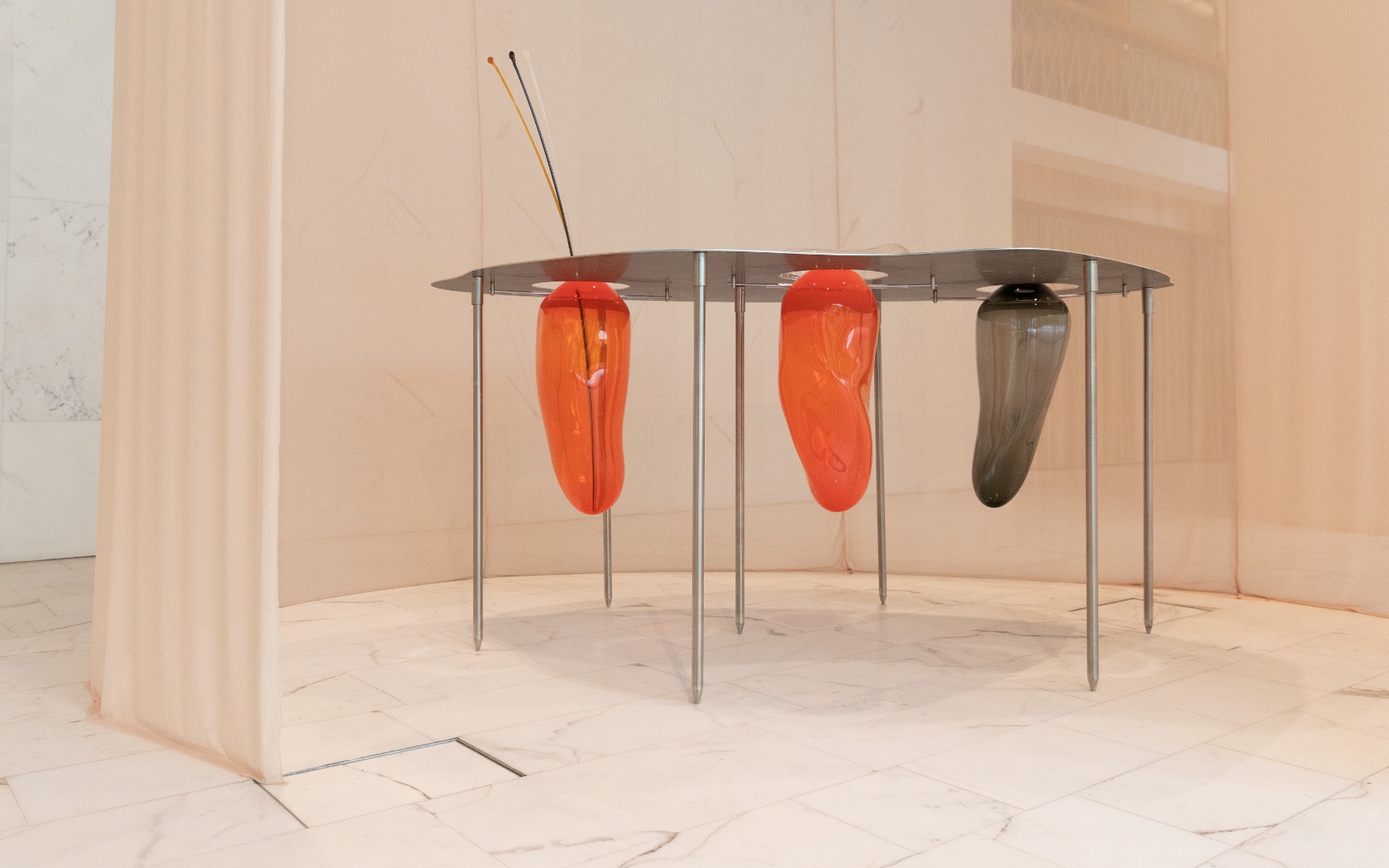
Pharma helps us in our fight against Covid, but it has also received a lot of criticism for ruling our lives and the world. How did things fare with the artists being aware of this criticism and still being able to create meaningful work? What was your strategy in this regard?
It is very difficult to be political if you’re a guest in someone else’s house. A lot of people don’t like the pharmaceutical companies because of animal testing and other reasons. I think the only good thing we can do when doing art shows is to break down barriers. I don’t think we need to do much more. Some people can enjoy it and see it as a positive way to have a foot in the door. Some people might be bothered by it. You just have to decide what will be your losses and what will be your wins.
I think the only good thing we can do when doing art shows is to break down barriers. I don’t think we need to do much more.
Working in such a complex and rich environment as Basel, where so many interests are involved, you have to be very smart to operate as a curator.
Exactly. There’s a lot of money here.
On a philosophical note – the theme of Parcours this year is a response to the query “Can We Find Happiness Together Again?”. Why did you pose this question?
Because of the lack of being able to physically meet each other. I think we can all agree that in these last months we were slowly becoming demoralised – on a global level – through not being able to connect, through not being able to visit each other as freely as we used to, and all that stuff. Two years ago, everybody talked about “art fair fatigue”, “market fatigue”, but nevertheless, on a meta level, it is about coming together and enjoying the art together. It does create a sense of happiness. I have never seen so many happy faces during Art Basel. It’s a relief.
Two years ago, everybody talked about “art fair fatigue”, “market fatigue”, but nevertheless, on a meta level, it is about coming together and enjoying the art together. It does create a sense of happiness.
Nobody believed it would happen. I didn’t believe Art Basel would be taking place until it was time to install the works. It felt surreal. Every day someone would ask me: Is the fair really happening in ten days? In a week? And I was like: I think so… Everybody shipped their stuff, things were printed… but two weeks before the start, it was still hanging by a thread. Up until the very last moment, bad news was coming in: restriction changes because of the vaccine, etc. It is a small miracle that it is happening, and that people came. And a lot of good people came. And I’m hearing from the galleries that sales were good for a lot of them. Even though this is not where we are normally at, it’s great that we did it and didn’t just skip another year. I think that would have been detrimental to everyone.
I didn’t believe Art Basel would be taking place until it was time to install the works. It felt surreal. Every day someone would ask me: Is the fair really happening?
Many suicides have happened in-between…
Yeah.
Claudia Comte: The Interview Painting Ensemble (mise-en-scène in 12 Acts), 2021, presented by König Galerie, Gladstone Gallery / Art Basel press photo
In an interview with Claudia Comte, you mention the concept of empathy. The Art Basel fair is very aggressive – it’s corporate, it’s a big business – whereas Parcours asks for empathy, for lowering our barriers and connecting with artworks and others. That’s quite a big shift. Do you think people are becoming more mindful of one another? How do you wish things were?
That’s a deep question. I think today it is good to accept the positive and stay hopeful. I think we know from history repeating itself that humans are generally not good at exercising empathy. Otherwise we wouldn’t have such a mess in the world in terms of everything we do. I think the danger of us returning to the good old times and forgetting about all this because we also want to forget the hard times is, of course, very possible. But this process resets our values and the reasons why we are in this business. It did for me. We care about the art, we care about certain people in the art world (not the ones just in it for the business). I think many people are still re-checking their focus and what is important to them. You realise what your strong points are when you’re going through a pandemic, as well as the points where you’re more rushed and not concentrating enough.
You realise what your strong points are when you’re going through a pandemic, as well as the points where you’re more rushed and not concentrating enough. For me, this was a valuable time.
For me, this was a valuable time. Will it specifically bring something for us in the future? Who knows! It’s a money-driven business (the art fair context), but at the same time, it is a very important business – we all know that. Art Basel still is the place where many galleries do most of their turnaround. Even today. There is no other fair even close to it. If you can make half of your year’s salary in one week, there’s no need to argue if it’s good or not. It’s two different realities: an art fair and curating work. As a curator, I still go through the fair to scout for new artists. A good-quality fair is the best place to discover things. It’s a condensed version of an art world.
A good-quality fair is the best place to discover things. It’s a condensed version of an art world.
For you as a curator, does Basel as a city provide you with enough creative inspiration? Notwithstanding the fact that you were born here and that you have family here.
The ability to regularly go away from the place you know well is the biggest inspiration to stay there. Even though it is culturally a very inspiring place, Switzerland is very small; the cities are very small – you cannot compare them to the great capitals of the world. Being located in the centre of Europe, it’s a great location to travel from. As long as you can travel for work, this place is a great home. If you can’t ever leave your home, any place is bad.